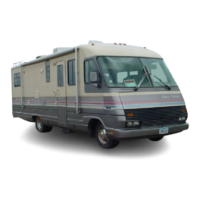3.
Keep
the
valve on an
empty
tank
tightly
closed.
4.
Have
the
gas
tank
purged by
the
LP
gas ser-
vice
station
if
freeze
up
occurs.
5. Have
the
LP
service station
inject
an approved
antifreeze
or
deicer
into
the
tank.
Be
sure you
have
the
proper gas blend
for
your traveling
area.
If
you have
the
proper gas blend,
it
is very
unlikely
that
the
gas is
at
fault.
If,
despite
precaution, you do experience freeze up,
try
melting
the
ice
by
warming
the
regulator using
a
small
light
bulb.
DO
NOT USE
AN
OPEN FLAME.
Once
flow
is restored, make certain
that
the
regulator
cover
Is
properly
reinstalled
to
prevent
water
from
entering
the
regulator
which
will
cause
it
to
freeze
again.
If
the
problem
persists, !lsk your
LP
gas sup-
plier
to
service
the
tank
or
regulator as required.
Aside
from
the
possibilities
of
freezing during
cold
temperatures,
your
LP gas system
performance
isaf-
fected
significantly
as
the
temperature drops. The
liquid
in
the
tank
is,
of
course,
much
colder
than
the
air
that
normally
surrounds
the
tank. The liquid in
the
tank
vaporizes
by
absorbing heat
from
the
surroun-
ding
air.
But
as
the
air temperature drops closer
to
the
temperature
of
the
liquid in
the
tank,
the
liquid
doesn't
vaporize
as
easily. Consequently,
the
BTU
value
of
the
LP
drops
dramatically.
The
following
chart
shows
the
reduction in
BTU
availability
of
propane gas
as
the temperature falls:
20
lb.
Tank'
%
FULL
+
20
0
0°
_5°
-10
0
-
15°
60%
36.000
18.000
12.750
8.500
4.250
50%
32.400
18.200
12.150
8.100
4.050
40%
28.800
14.400
11,400
7.600
3.800
30%
25.200
12.600
10,450
7.300
3.150
20%
21.600
10.800
8.100
5,400
2,700
10%
16.200
8.100
6.075
4.050
2.025
'30
lb.
Tank
multiply x
1.40
The
chart
clearly
shows
how
the
availability
of
the
gas
is
reduced
at
lower
temperatures.
With
this in
mind,
keep
your
LP
tank
as full
as
possible during
cold
weather.
Check
the
BTU/hr rating plates on your
LP appliances. This
information
will help you manage
your
LP gas
requirements
efficiently.
FILLING
LP
GAS
TANKS
To
fill
the
chassis-mounted
storage
tank.
drive the
vehicle
to
an
LP
gas supplier or one
of
the
service
stations
which
sell
LP
gas.
WARNING:
TURN OFF
LP
GAS
MAIN
VALVE
BEFORE FILLING
LP
GAS
TANK
OR
ENTERING
AN
LP
GAS
BULK PLANT
OR
MOTOR
FUEL
SER·
VICE
STATION.
TURN OFF ALL PILOT LIGHTS
AND
APPliANCES
INDIVIDUALLY
BEFORE
RE-
FUELING
OF
MOTOR
FUEL TANKS AND/OR
35
PERMANENTlY
MOUNTED
LP-GAS
CON·
TAINERS. WHEN NOT
INDIVIDUALLY
TURNED
OFF,
AUTOMATIC IGNITION APPLIANCES
MAY
CONTINUE TO SPARK WHEN
LPGAS
IS
TURN·
ED
OFF
AT
THE CONTAINER. DO
NOT
FILL
LP
GAS CONTAINERS TO MORE
THAN
80%
OF
CAPACITY.
LP
GAS
SYSTEM
LEAK CHECKS
The smell
of
LP gas (actually. an
additive,
ethy
mercaptan) indicates a leak.
Obvious
leak sources
are
fittings,
valves, and couplings.
For
your
safety, check
for
leaks in
your
gas
system
each time the tank is filled or before each trip. Alw1!Ys
check the system any
time
you
detect
a garlic-like
odor.
To perform a leak check,
swab
a
mixture
·of a
non-
ammoniated, non-chlorinated soap
solution
or
an ap-
proved leak detection solution
over
each
fitting,
joint
and connection
in
the
system.
Open
the
tank
ser-
vice valve. Inspect each
joint.
If
even
the
smallest
bubbles appear
at
any joint, this
joint
must
be remade.
Refer repairs
to
an authorized
Fleetwood
service
center, or your
LP
gas service
facility.
Never
attempt
to
repair gas piping
without
proper
tools
and
know-how.
Potential trouble spots
for
leaks are areas
where
piping runs close
to
chassis and frame members. Look
for
chafes and cracks around pipe hangers.
If
you
find
defects
in any
LP
gas
system
component,
have
it
repaired or replaced before using
the
system.
As
an
added precaution, do a visual
check
of
all
exposed piping and
fittings
after
you have. arrived
at
a destination and before you use
the
LPG
system.
Travel and road shocks
may
have caused
damage
to
the system
that
you
will
need
to
repair
before
us-
ing the appliances.
WARNING: NEVER
CHECK FOR LEAKS
WITH
AN
OPEN
FLAME. DO
NOT
CHECK COPPER
AND BRASS PLUMBING LINES
AND
FITTINGS
FOR
LEAKS
USING
AMMONIATED
OR
CHLORINATED HOUSEHOLD TYPE
DETER-
GENTS.
THESE
CAN CAUSE CRACKS
TO
FORM
ON
THE LINE
AND
BRASS FITTINGS. IF THE
LEAK
CANNOT
BE
LOCATED, TAKE THE
UNIT
TO
AN
LP
GAS SERVICE REPRESENTATIVE.
Keep
the
tank valve closed and
turn
off
all ap-
pliances
if
the
unit is
not
being used.
WARNING:
DO
NOT
USE
PLIERS
OR
A WRENCH
TO
TIGHTEN
VALVES.
IF
A VALVE
IS
NOT LEAK-TIGHT WHEN
CLOSED
BY
HAND.
SEE
AN
LP
GAS SERVICE
REPRESENTATIVE.
LPG Leak
Detector
A permanently installed
LPG
gas leak
detector
is
located near the floor in the galley area. The
unit
con-
tains
an
alarm
that
will sound alerting
you
to
the

